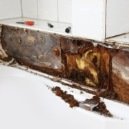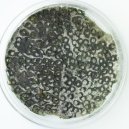Find a pre-screened local mold removal specialist Free Estimate
Find a Mold Specialist Now
Click or Call, Toll-Free 24/7
Mold In The Garage
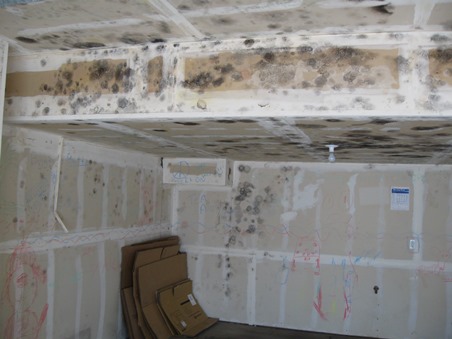
Mold in the garage is a pretty common problem. While homes usually have good ventilation to help prevent mold growth, garages are another matter. In addition to poor ventilation, simply driving a car into the garage in rainy or snowy weather tracks in a lot of water that can lead to mold growth. Mold can be found in many places in garages, though, not only on the floors or walls. Boxes of stored belongings and stacks of magazines or newspapers can get moldy. Camping equipment or summer supplies may get moldy, especially if put away damp.
Risks Associated With Mold in The Garage
Most people know, or at least have some idea, why mold in the house is dangerous. It can lead to serious health problems, including asthma attacks, pneumonia, other respiratory disorders, migraine headaches and allergic reactions, as reported by the Environmental Protection Agency(1).
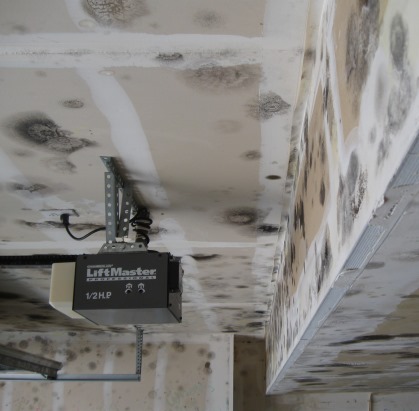
Mold in your garage can cause all the same health problems as mold in your house. Mold in your garage may pose a lesser risk initially, though, simply because most people don’t spend a lot of time in their garage. However, garages are not airtight. Just as carbon monoxide can seep into your house if you leave your car running in your garage, so can mold spores and mycotoxins (harmful chemicals produced by mold) make their way into your home from the garage.
Not only can this make you sick but mold spores can then settle in your home and start growing. While mold in the garage may be a slightly less urgent problem than mold in the house, it’s still something that needs to be taken care of in a timely manner.
Mold on The Concrete Garage Floor
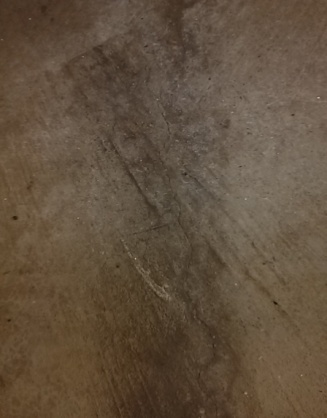 Mold on concrete garage floor
Mold on concrete garage floorMold does not grow well on concrete itself, but you may find it on concrete floors for a couple of reasons.
First, when concrete gets wet and then dries, mineral deposits are often left behind. These may look like mold by they really are not. However, mold may begin to grow on these mineral deposits (see picture).
Second, people often choose to paint their garage floors because they like the way it looks. Mold grows easily on most types of paint. In addition, it may be harder to see mold growing on a painted floor, depending on the color of paint, so you may not notice the problem until it’s gotten pretty bad. If you want to paint your garage floor, we strongly recommend using mold-resistant paint (available in a variety of colors at many home improvement stores).
Removing Mold on The Concrete Garage Floor
To remove mold from a concrete garage floor, Brian Turner, author of A Homeowner’s Complete Guide to Performing Mold Remediation, recommends using a wire brush to scrub mold and mineral deposits off the floor or using a wire brush and a scraper to remove paint and mold. Use a vacuum with a HEPA filter to remove all debris before disinfecting the entire surface with an antifungal cleanser.
Make sure you wear protective gear, including an N-95 respirator mask, when removing mold so you don’t expose yourself to mold spores that can make you sick in the process.
You should also check for mold in other areas of the garage. Don’t assume mold is only on the floor.
Removing Mold on The Walls And Ceiling
Mold on the garage walls and ceiling should be removed the same way as mold that is growing inside your home. Here is more on the mold removal process.
For Help Getting Rid of Mold in the Garage
If you need help getting rid of mold in your garage, or if you’re concerned mold might have spread and you want to make sure you found it all, we recommend scheduling a free inspection and consultation with a qualified mold remediation professional. A professional will inspect your garage for mold and advise you about the steps that need to be taken. Even if you plan to do the work yourself, you can benefit from some free expert advice. To find a mold remediation professional near you, just follow the link.
Return From Mold In The Garage To Home Page
(1)EPA: Health Risks
Free Home Inspection By A Mold Removal Specialist
Search This Website
Recent Articles
-
See Our 5 Recommended Mold Removal Companies in Covington, KY
Apr 16, 25 12:59 PM
-
See Our 5 Recommended Mold Removal Companies in Wheaton, IL
Jun 20, 24 10:33 AM
-
See Our 5 Recommended Mold Removal Companies in Aberdeen, SD
Oct 08, 21 04:05 PM

